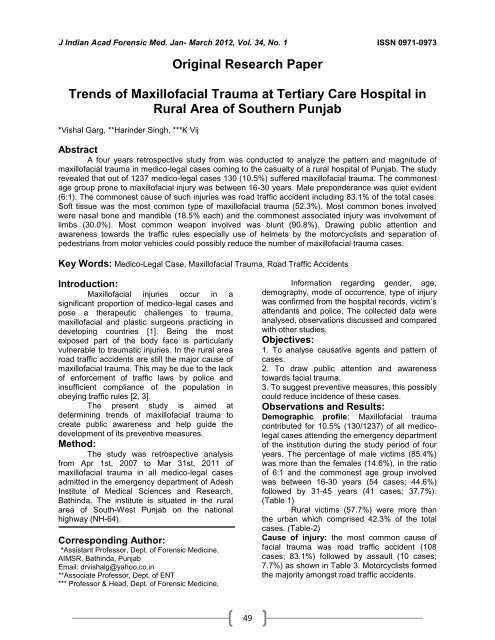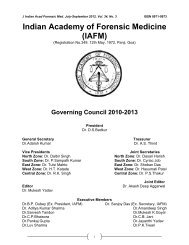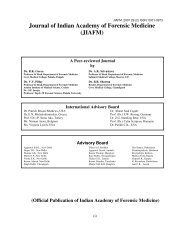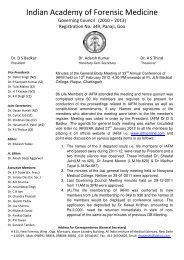Indian Academy of Forensic Medicine (IAFM) - Official website of IAFM
Indian Academy of Forensic Medicine (IAFM) - Official website of IAFM
Indian Academy of Forensic Medicine (IAFM) - Official website of IAFM
Create successful ePaper yourself
Turn your PDF publications into a flip-book with our unique Google optimized e-Paper software.
J <strong>Indian</strong> Acad <strong>Forensic</strong> Med. Jan- March 2012, Vol. 34, No. 1 ISSN 0971-0973<br />
Original Research Paper<br />
Trends <strong>of</strong> Maxill<strong>of</strong>acial Trauma at Tertiary Care Hospital in<br />
Rural Area <strong>of</strong> Southern Punjab<br />
*Vishal Garg, **Harinder Singh, ***K Vij<br />
Abstract<br />
A four years retrospective study from was conducted to analyze the pattern and magnitude <strong>of</strong><br />
maxill<strong>of</strong>acial trauma in medico-legal cases coming to the casualty <strong>of</strong> a rural hospital <strong>of</strong> Punjab. The study<br />
revealed that out <strong>of</strong> 1237 medico-legal cases 130 (10.5%) suffered maxill<strong>of</strong>acial trauma. The commonest<br />
age group prone to maxill<strong>of</strong>acial injury was between 16-30 years. Male preponderance was quiet evident<br />
(6:1). The commonest cause <strong>of</strong> such injuries was road traffic accident including 83.1% <strong>of</strong> the total cases.<br />
S<strong>of</strong>t tissue was the most common type <strong>of</strong> maxill<strong>of</strong>acial trauma (52.3%). Most common bones involved<br />
were nasal bone and mandible (18.5% each) and the commonest associated injury was involvement <strong>of</strong><br />
limbs (30.0%). Most common weapon involved was blunt (90.8%). Drawing public attention and<br />
awareness towards the traffic rules especially use <strong>of</strong> helmets by the motorcyclists and separation <strong>of</strong><br />
pedestrians from motor vehicles could possibly reduce the number <strong>of</strong> maxill<strong>of</strong>acial trauma cases.<br />
Key Words: Medico-Legal Case, Maxill<strong>of</strong>acial Trauma, Road Traffic Accidents<br />
Introduction:<br />
Maxill<strong>of</strong>acial injuries occur in a<br />
significant proportion <strong>of</strong> medico-legal cases and<br />
pose a therapeutic challenges to trauma,<br />
maxill<strong>of</strong>acial and plastic surgeons practicing in<br />
developing countries [1]. Being the most<br />
exposed part <strong>of</strong> the body face is particularly<br />
vulnerable to traumatic injuries. In the rural area<br />
road traffic accidents are still the major cause <strong>of</strong><br />
maxill<strong>of</strong>acial trauma. This may be due to the lack<br />
<strong>of</strong> enforcement <strong>of</strong> traffic laws by police and<br />
insufficient compliance <strong>of</strong> the population in<br />
obeying traffic rules [2, 3].<br />
The present study is aimed at<br />
determining trends <strong>of</strong> maxill<strong>of</strong>acial trauma to<br />
create public awareness and help guide the<br />
development <strong>of</strong> its preventive measures.<br />
Method:<br />
The study was retrospective analysis<br />
from Apr 1st, 2007 to Mar 31st, 2011 <strong>of</strong><br />
maxill<strong>of</strong>acial trauma in all medico-legal cases<br />
admitted in the emergency department <strong>of</strong> Adesh<br />
Institute <strong>of</strong> Medical Sciences and Research,<br />
Bathinda. The institute is situated in the rural<br />
area <strong>of</strong> South-West Punjab on the national<br />
highway (NH-64).<br />
Corresponding Author:<br />
*Assistant Pr<strong>of</strong>essor, Dept. <strong>of</strong> <strong>Forensic</strong> <strong>Medicine</strong>,<br />
AIMSR, Bathinda, Punjab<br />
Email: drvishalg@yahoo.co.in<br />
**Associate Pr<strong>of</strong>essor, Dept. <strong>of</strong> ENT<br />
*** Pr<strong>of</strong>essor & Head, Dept. <strong>of</strong> <strong>Forensic</strong> <strong>Medicine</strong>,<br />
49<br />
Information regarding gender, age,<br />
demography, mode <strong>of</strong> occurrence, type <strong>of</strong> injury<br />
was confirmed from the hospital records, victim’s<br />
attendants and police. The collected data were<br />
analysed, observations discussed and compared<br />
with other studies.<br />
Objectives:<br />
1. To analyse causative agents and pattern <strong>of</strong><br />
cases.<br />
2. To draw public attention and awareness<br />
towards facial trauma.<br />
3. To suggest preventive measures, this possibly<br />
could reduce incidence <strong>of</strong> these cases.<br />
Observations and Results:<br />
Demographic pr<strong>of</strong>ile: Maxill<strong>of</strong>acial trauma<br />
contributed for 10.5% (130/1237) <strong>of</strong> all medicolegal<br />
cases attending the emergency department<br />
<strong>of</strong> the institution during the study period <strong>of</strong> four<br />
years. The percentage <strong>of</strong> male victims (85.4%)<br />
was more than the females (14.6%), in the ratio<br />
<strong>of</strong> 6:1 and the commonest age group involved<br />
was between 16-30 years (54 cases; 44.6%)<br />
followed by 31-45 years (41 cases; 37.7%).<br />
(Table 1)<br />
Rural victims (57.7%) were more than<br />
the urban which comprised 42.3% <strong>of</strong> the total<br />
cases. (Table-2)<br />
Cause <strong>of</strong> injury: the most common cause <strong>of</strong><br />
facial trauma was road traffic accident (108<br />
cases; 83.1%) followed by assault (10 cases;<br />
7.7%) as shown in Table 3. Motorcyclists formed<br />
the majority amongst road traffic accidents.









